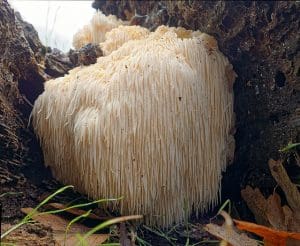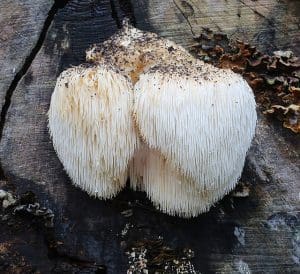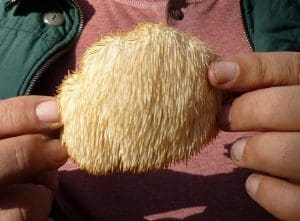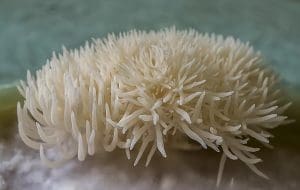The Lion’s Mane Fungus / Summer / Autumn / Winter / Edible
Scientific Name
Hericium Erinaceus
Common Names
The Lion’s Mane Fungus, Bearded Tooth, Tree Hedgehog Fungus, Pom-pom Mushroom, Monkey Head mushroom.
Family
Hericiaceae
Habitat
They are very rare in the UK but can occasionally be found on dead or badly diseased beech and oak trees.
Description
A very rare fungus in the UK, they are protected under Schedule 8 of the Wildlife and Countryside Act 1981, this is the highest legal protection available to plants and fungi so they are illegal to collect and should be left well alone. They can be successfully grown from plug spawn at home.
Identifying Features:
Cap:
The fruit body is generally roundish in shape, covered in spines that cascade down, giving it the appearance of a frozen waterfall or lion’s mane. The spines are up to 5cm longs and pointed. Overall the colour is off white to yellow, darkening with age. They are attached to the tree by a thick but short stipe. They lack any gills, pores etc. instead the spores are released from the tips of the spines.

Smell:
Slightly musty, getting stronger with age
Spores:
White.
Uses
In food
A real gourmet mushroom which to some tastes like lobster. Their texture is quite meaty so they work well as a vegan substitute. As they get older they tend to get tough so young examples are the best.

As Medicine
The Lions Mane Fungus has a long history of use in Chinese medicine and is used to treat a multitude of aliments. Modern research shows that it contain compounds that are effective against memory loss, depression, anxiety, dementia, neurological disorders and cancer.

Harvesting
They are very rare and protected by law so should not be gathered in the wild however they can be cultivated quite easily at home. Spawn plugs are available online or the fresh mushrooms sometimes appear in Asian supermarkets. If they are successfully grown they can reappear for up to 20 years, it is hypothesized that they can live up to 40 years.
Known hazards
None Known.
Potential lookalikes
There are two other Hericium species in the UK, which both also live on beech trees. They are also very scarce so should not be collected. The Tiered Tooth Fungus (Hericium Cirrhatum) has tiered layers of white brackets with short, white spines. The Coral Toothed Fungus (Hericium Coralloides) also looks quite similar but this is much rarer and doesn’t tend to fruit as high up on standing trees. This species looks a little like coral, hence its common name.
Extra Notes
Both the genus name Hericium and the species name Erinaceus mean ‘hedgehog’ in Latin.
3 replies on “The Lion’s Mane Fungus (Hericium Erinaceus) Identification”
Leave a Reply
You must be logged in to post a comment.







Absolutely fascinating
I have a fungi which looks like Lion’s Mane outside my back door. What should I do?
Hey, how amazing, it’s quite rare and not advised to pick so let it sit there, spread it’s spores and do its thing. Look at it fondly 🙂